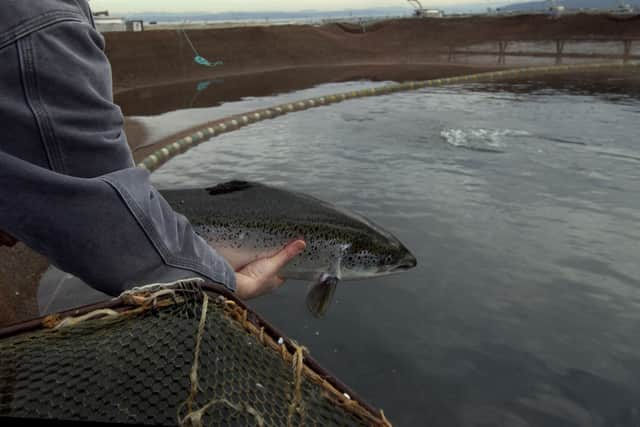Sea lice: salmon bites and rashes explained, could they come to the UK - are they dangerous to humans?
and live on Freeview channel 276
Footage captured by a drone at an Icelandic fish farm obtained by The Guardian and showing a distressing scene of severely diseased, dead and dying salmon has been characterised by a veterinary expert as an unprecedented "animal welfare catastrophe."
The video, filmed last week above an open-sea cage in the remote Westfjords region of Iceland, shows salmon grappling with an overwhelming sea lice infestation, an infestation so dire that a substantial number had to be culled prematurely.
Advertisement
Hide AdAdvertisement
Hide AdIt is estimated that up to 12 sea pens - housing approximately a million fish last month - have fallen prey to the parasites, though precise numbers remain unconfirmed.
The footage also shows the presence of a specialised vessel, the Hordafor III, dispatched from Norway to carry out the euthanasia of the afflicted fish.
Mast, the Icelandic food and veterinary authority, said that the two companies responsible for the sea pens in Tálknafjörður - Arctic Fish and Arnarlax - have opted to cull the impacted salmon, as they are not suitable for human consumption. Following the culling process, the fish will be processed for use in animal feed.
Berglind Helga Bergsdóttir, an expert in fish diseases at MAST, the Icelandic food and veterinary authority, noted that Iceland had never witnessed such an extensive infestation of lice before.
Advertisement
Hide AdAdvertisement
Hide Ad“The lesions don’t get much worse than this,” said Bergsdóttir, adding that bacterial infections were exacerbating the wounds, making them deeper and more extensive. “What has surprised everyone here is how quickly it happened.”
As Paris grapples with recent bed bug infestations, it raises the question of whether a parallel threat from sea lice could emerge, shedding light on the potential risks these aquatic parasites may pose to humans. Here is everything you need to know.
What are sea-lice?


The parasite responsible for the issue is a crustacean called a salmon lice, scientifically known as Lepeophtheirus salmonis.
This parasite can attach itself to the skin, fins and gills of salmon, and feeds on the host fishes' mucus, skin and blood, leading to the formation of open sores, which, in turn, induce stress and weaken the immune system.
Advertisement
Hide AdAdvertisement
Hide AdIn severe instances, this infestation can result in large-scale deaths among the salmon population.
Mast is currently probing the root cause of the Icelandic incident, a situation which escalated following the authority's authorisation for the use of insecticide as a treatment for the outbreak.
The insecticide proved ineffective in eliminating all the lice, resulting in the infestation's rapid expansion. The agency is exploring the possible theory that the lice may have undergone a mutation.
“We know lice are very adaptable and one method they use is mutation, especially with the drugs," Bergsdóttir said.
Advertisement
Hide AdAdvertisement
Hide AdTrygve Poppe, a salmon expert and former professor of fish health at the Norwegian school of veterinary science explained how pain and blood loss is inflicted upon the fish by these lice.
“You can see from the pink heads, the skin barrier between the fish and the water is completely gone,” he said. “The fish are leaking, causing a loss of balance. Most of the fish are just moribund. We are seeing the terminal stages of their lives.”
Are salmon lice a risk to humans?
Salmon lice are not considered a direct danger to humans, as they are adapted to infest and feed on the skin and tissues of salmon and other fish, and do not generally target or harm humans.
However, if someone were to come into contact with salmon that are heavily infested with lice, there could be concerns about hygiene and potential skin irritation, but this would be a rare and indirect risk.
Advertisement
Hide AdAdvertisement
Hide AdWhile they may cause skin irritations or discomfort to fish, the lices' interactions with humans are typically minimal and do not result in the types of bites or rashes often associated with insects like mosquitoes or bed bugs.
The primary concern with salmon lice is their effect on the aquaculture industry and salmon farming, as they can cause economic losses and in wild salmon populations where they can contribute to health problems and reduced survival rates.
Proper management and control measures are employed in aquaculture to mitigate the effects of salmon lice on farmed fish, and the lice can also have negative ecological impacts when they affect wild salmon populations.
In August, the escape of 3,500 salmon from a farm under the ownership of Arctic Fish - one of the companies operating pens in Tálknafjörður, where the current lice outbreak is occurring - triggered an outcry among environmentalists and prompted an investigation by Icelandic law enforcement.
Advertisement
Hide AdAdvertisement
Hide AdThe escape sparked a protest led by renowned Icelandic singer Björk, who has collaborated with the Catalan artist Rosalía to release a song, the proceeds of which will support activists engaged in the fight against salmon farms, which she asserts are causing a "devastating effect" on Icelandic wildlife.
The potential for sea lice infestations to occur in the UK's waters does exist, and they have affected various regions worldwide, including Norway, Scotland and Iceland.
Comment Guidelines
National World encourages reader discussion on our stories. User feedback, insights and back-and-forth exchanges add a rich layer of context to reporting. Please review our Community Guidelines before commenting.
